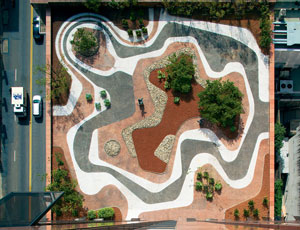9.18.24 — Crafting the Middle Class
“Crafting Modernity” tells a familiar story, about a world torn apart and renewed by Depression and world war. Only one thing: this time it unfolds with a tapestry, a table, and a chair—and on another continent entirely. Make yourself at home.
You know the story, about modern life and modern art. As recovery looked more and more urgent and more possible, it brought not a revival of the gilded age, but a home life that many more could call their own. Middle-class comforts included much that could not have existed before the twentieth century. Renowned artists and designers embraced the cause, with furnishings that many more could afford, without the stifling air of Edwardian wallpaper.  In no time, capitalism made that cause a consumer revolution, as craft gave way to new technologies and new pressures to spend. If it thus took back its own promises, it sound surprisingly like change today—only centered not on Asia, Silicon Valley, or Madison Avenue, but Latin America at the Museum of Modern Art, through September 22.
In no time, capitalism made that cause a consumer revolution, as craft gave way to new technologies and new pressures to spend. If it thus took back its own promises, it sound surprisingly like change today—only centered not on Asia, Silicon Valley, or Madison Avenue, but Latin America at the Museum of Modern Art, through September 22.
If you have heard this story before, it may well be at MoMA as well. In 2015 it presented the same four decades of Latin American architecture, ending around 1980. You may recognize Oscar Niemeyer and Lina Bo Bardi, whose architecture appears along with others projected on the walls, as a backdrop for what might have stood inside. Here, though, they contribute furniture—Niemeyer a low table, suitable for stacking or a communal meal on the floor. Bo Bardi brings quite an array of chairs. Roberto Burle Marx, who with Niemeyer created buildings for the new capital city of Brasilia, has a painting, like a sketch toward the new interior design.
The museum is out to extend what one even means by design. Gego appears not for her wire sculpture, but for wiry white diagonals on a huge hanging. Olga de Amaral, also with art of the Andes now at the Met, and Cynthia Sargent display fabric as well—and I also work this together with an earlier report on that show at the Met as a longer review and my latest upload. Here, though, it appears not as art for itself but tapestry for the home. The filmed architecture, in turn, sticks to homes, not to massive public projects. It is remaking modern life one family at a time.
Still, it is remaking private life in public. Chairs appear by far the most often, not bedroom furniture, and films focus on exteriors and common spaces. The International Style favored slim columns and glass houses, which allow one to look out on nature, but also allow others to look in. The curators, Ana Elena Mallet and Amanda Forment, feature just six countries, to give their distinct traditions their due. At least one artist claims to draw on pre-Colombian art, but be careful. One might just as well speak of global art in a newly global economy.
A long wall diagrams each country’s social networks, like maps of the art world for Mark Lombardi. They testify instead to interactions and displacement. Naturally they include Josef Albers, Anni Albers, and others from the Bauhaus, but also Alexander Calder, Black Mountain College in New England, and ever so much more. In the show as a whole, artists can trace their origins to a dozen European nations and the United States. But you have heard that story before, too, about refugees from fascism who helped create postwar art. No wonder furniture had an eye to portability and reassembly in the face of exile—like Niemeyer’s Modulo, a “puzzle chair,” or lounge furniture from Roberto Matta that fits neatly together as a square.
Assembly and repetition also encourage the shift from craft to brand names. Antonio Bonet, Juan Kurchan, and Jorge Ferrari Hardoy (later Grupo Austral) gave their initials to the B.K.P. chair, a descendant of the Marcel Breuer chair with its tube frame and suspended leather. They conceived it not in Argentina, but in the Paris studio of Le Corbusier—and copies quickly entered Fallingwater, the Frank Lloyd Wright house, and the Museum of Modern Art. International enough for you? MoMA provided another spur to invention with a 1940 design competition. Several of the chairs look out on the museum’s sculpture garden now.
Both threads, craft and commerce, offer surprises. Other brand names include a logo for Olivetti typewriters. Ceramics, as with Colette Boccari, may depart from a perfect circle, as if fresh from the oven, without losing their subtle color. High tech can have an industrial look, too, like flashlights by Emilio Ambasz that could pass in reproduction for pipes. Much the same red plastic enlivens a bar cart, an ice bucket, and a TV. Sit down, turn on, and pour yourself a drink.
Read more, now in a feature-length article on this site.